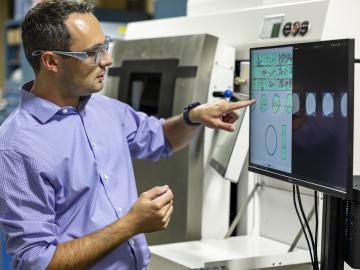Filter News
Area of Research
- (-) Advanced Manufacturing (34)
- (-) Biological Systems (18)
- (-) Fusion and Fission (54)
- (-) National Security (79)
- Biology and Environment (177)
- Biology and Soft Matter (5)
- Building Technologies (12)
- Chemical and Engineering Materials (4)
- Chemistry and Physics at Interfaces (11)
- Clean Energy (522)
- Climate and Environmental Systems (14)
- Computational Biology (6)
- Computational Chemistry (5)
- Computational Engineering (5)
- Computer Science (19)
- Data (1)
- Earth Sciences (1)
- Electricity and Smart Grid (3)
- Energy Frontier Research Centers (14)
- Energy Sciences (5)
- Fossil Energy (3)
- Fuel Cycle Science and Technology (3)
- Functional Materials for Energy (16)
- Fusion Energy (17)
- Geographic Information Science and Technology (3)
- Isotope Development and Production (3)
- Isotopes (35)
- Materials (433)
- Materials Characterization (2)
- Materials for Computing (36)
- Materials Synthesis from Atoms to Systems (13)
- Materials Under Extremes (12)
- Mathematics (1)
- Neutron Data Analysis and Visualization (4)
- Neutron Science (190)
- Nuclear Science and Technology (74)
- Nuclear Systems Modeling, Simulation and Validation (3)
- Nuclear Systems Technology (1)
- Quantum Condensed Matter (4)
- Quantum information Science (9)
- Reactor Technology (1)
- Renewable Energy (4)
- Sensors and Controls (5)
- Supercomputing (311)
- Transportation Systems (11)
News Topics
- 3-D Printing/Advanced Manufacturing (27)
- Advanced Reactors (8)
- Artificial Intelligence (14)
- Big Data (6)
- Bioenergy (7)
- Biology (6)
- Biomedical (4)
- Biotechnology (1)
- Buildings (2)
- Chemical Sciences (6)
- Climate Change (5)
- Composites (4)
- Computer Science (22)
- Coronavirus (2)
- Critical Materials (1)
- Cybersecurity (20)
- Decarbonization (4)
- Energy Storage (6)
- Environment (7)
- Exascale Computing (2)
- Fossil Energy (1)
- Frontier (2)
- Fusion (24)
- Grid (8)
- High-Performance Computing (6)
- Isotopes (1)
- ITER (6)
- Machine Learning (13)
- Materials (9)
- Materials Science (12)
- Microscopy (1)
- Nanotechnology (2)
- National Security (34)
- Net Zero (1)
- Neutron Science (7)
- Nuclear Energy (33)
- Partnerships (7)
- Physics (2)
- Quantum Science (1)
- Security (13)
- Simulation (4)
- Space Exploration (2)
- Summit (2)
- Sustainable Energy (12)
- Transformational Challenge Reactor (1)
- Transportation (4)
Media Contacts

Researchers at the Department of Energy’s Oak Ridge National Laboratory have improved flaw detection to increase confidence in metal parts that are 3D-printed using laser powder bed fusion.

In fiscal year 2023 — Oct. 1–Sept. 30, 2023 — Oak Ridge National Laboratory was awarded more than $8 million in technology maturation funding through the Department of Energy’s Technology Commercialization Fund, or TCF.

The heat is on at this year’s Molten Salt Reactor Workshop – where top research and industry minds are melding to advance development on molten salt technology – at ORNL.

As vehicles gain technological capabilities, car manufacturers are using an increasing number of computers and sensors to improve situational awareness and enhance the driving experience.

The Department of Energy’s Oak Ridge National Laboratory hosted the second 2023 cohort of the International Atomic Energy Agency’s Lise Meitner Programme in October.

Mike Benson has spent the last 10 years using magnetic resonance imaging systems — much as you find in a hospital — to understand the fluid dynamics of flows around objects and even scaled replicas of cities. He aims to apply MRI scanning to

ORNL will lead three new DOE-funded projects designed to bring fusion energy to the grid on a rapid timescale.

The Department of Energy’s Oak Ridge National Laboratory announced the establishment of the Center for AI Security Research, or CAISER, to address threats already present as governments and industries around the world adopt artificial intelligence and take advantage of the benefits it promises in data processing, operational efficiencies and decision-making.

The Department of Energy’s Oak Ridge National Laboratory hosted its Smoky Mountains Computational Science and Engineering Conference for the first time in person since the COVID pandemic broke in 2020. The conference, which celebrated its 20th consecutive year, took place at the Crowne Plaza Hotel in downtown Knoxville, Tenn., in late August.

Cadet Elyse Wages, a rising junior at the United States Air Force Academy, visited ORNL with one goal in mind: collect air.




